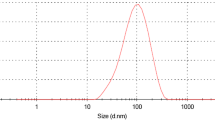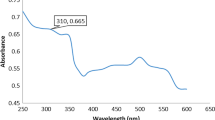Abstract
The aim of the present investigation was to evaluate the impacts of Zataria multiflora aromatic water (ZMAW) and nano emulsion (NE) of Z. multiflora essential oil (ZMEO) on IL-4 (Th2-derived cytokine) and IFN-γ (Th1-derived cytokine) concentrations in mice with hydatidosis. Sixty four healthy BALB/c female mice were intraperitoneally injected by 1500 live protoscoleces of Echinococcus granulosus. Five month after injection, the infected mice were divided into seven treatment groups, including: Albendazole (100 mg/kg), ZMAW (100 ml/L), Albendazole 100 + ZMAW (Albendazole 100 mg/kg and ZMAW 100 ml/L), Albendazole 50 + ZMAW (Albendazole 50 mg/kg and ZMAW 100 ml/L), Albendazole 100 + NE of ZMEO (Albendazole 100 mg/kg and NE of ZMEO 10 ml/L), albendazole 50 + NE of ZMEO (albendazole 50 mg/kg and NE of ZMEO 10 ml/L) and the control group with no treatment. The mice received the ZMAW, NE of ZMEO and/or albendazole through drinking water for 90 days. At the end of treatment (90 days), blood specimens were harvested from all mice. A significant reduction in IL-4 concentration was revealed in the albendazole 50 group + NE of ZMEO, when compared to the control group (P < 0.05). No significant difference was noticed for the IFN-γ concentration between the trial groups. Increased IFN-γ: IL-4 ratio was observed in the albendazole 50 + ZMAW, Albendazole 50 + NE of ZMEO, Albendazole 100 + NE of ZMEO groups in comparison with the control group (P < 0.05). The findings observed in the current study showed that the administration of ZMAW and NE of ZMEO along with albendazole could enhance the IFN-γ: IL-4 ratio (Th1/Th2 balance), which may have therapeutic value in the treatment of hydatid disease.
Similar content being viewed by others
References
Al-qaoud K, Abdel-Hafez SK (2008) The induction of T helper type 1 response by cytokine gene transfection protects mice against secondary hydatidosis. Parasitol Res 102:1151–1155
Atayi A, Borji H, Moazeni M, Saboor Darbandi M, Heidarpour M (2018) Zataria multiflora would attenuate the hepatotoxicity of long-term albendazole treatment in mice with cystic echinococcosis. Parasitol Int 67:184–187
Boskabady MH, Mehrjardi SS, Rezaee A, Rafatpanah H, Jalali S (2013) The impact of Zataria multiflora Boiss extract on in vitro and in vivo Th1/Th2 cytokine (IFN-γ/IL-4) balance. J Ethnopharmacol 150:1024–2031
Chaudhri N, Soni GC, Prajapati SK (2015) Nanotechnology: an advance tool for nano-cosmetics preparation. Int J Pharm Res Rev 4:28–40
Eckert J, Deplazes P (2004) Biological, epidemiological, and clinical aspects of echinococcosis, a zoonosis of increasing concern. Clin Microbiol Rev 17:107–135
Elissondo MC, Albani CM, Gende L, Eguaras M, Denegri G (2008) Efficacy of thymol against Echinococcus granulosus protoscoleces. Parasitol Int 57:185–190
El-On J (2003) Benzimidazole treatment of cystic echinococcosis. Acta Tropic 85:243–252
Gavara CG, López-Andújar R, Ibáñez TB, Ángel JMR, Herraiz AM, Castellanos FO, Ibars EP, Rodríguez FSJ (2015) Review of the treatment of liver hydatid cysts. World J Gastroenterol 21:124–131
Haji Mohammadi KH, Heidarpour M, Borji H (2018a) Allium sativum methanolic extract (garlic) improve therapeutic efficacy of albendazole against hydatid cyst: in vivo study. J Invest Surg 25:1–8
Haji Mohammadi KH, Heidarpour M, Borji H (2018b) In vivo therapeutic efficacy of the Allium sativum ME in experimentally Echinococcus granulosus infected mice. Comp Immunol Microbiol Infect Dis 60:23–27
Heidarpour M, Mohri M, Borji H, Moghdass E (2012) Oxidative stress and trace elements in camel (Camelus dromedarius) with liver cystic echinococcosis. Vet Parasitol 187:459–463
Heidarpour M, Mohri M, Borji H, Moghdass (2013a) Oxidant/antioxidant balance and trace elements status in sheep with liver cystic echinococcosis. Comp Clin Pathol 22:1043–1049
Heidarpour M, Mohri M, Borji H, Moghdass (2013b) Oxidant/antioxidant status in cattle with liver cystic echinococcosis. Vet Parasitol 195:131–135
Hernandez-Pomi A, Borras-Salvador R, Mir-Gisbert A (1997) Analysis of cytokine and specific antibody profiles in hydatid patients with primary infection and relapse of disease. Parasite Immunol 19:553–561
Jenkins P, Dixon JB, Rakha NK, Carter SD (1990) Regulation of macrophage-mediated larvicidal activity in Echinococcus granulosus and Mesocestoides corti (Cestoda) infection in mice. Parasitol 100:309–315
Kanazawa T, Asahi H, Hata H, Mochida K, Kagei N, Stadecker MJ (1993) Arginine-dependent generation of reactive nitrogen intermediates is instrumental in the in vitro killing of protoscoleces of Echinococcus multilocularis by activated macrophages. Parasite Immunol 15:619–623
Mahmoudvand H, Mirbadie SR, Sadooghian S, Fasihi Harandi M, Jahanbakhsh S, Saedi Dezaki E (2017) Chemical composition and scolicidal activity of Zataria multiflora Boiss essential oil. J Essent Oil Res 29:42–47
Moazeni M, Larki S, Oryan A, Saharkhiz MJ (2014a) Preventive and therapeutic effects of Zataria multiflora methanolic extract on hydatid cyst: an in vivo study. Vet Parasitol 205:107–112
Moazeni M, Larki S, Saharkhiz MJ, Oryan A, Lari MA, Alavi AM (2014b) In vivo study of the efficacy of the aromatic water of Zataria multiflora on hydatid cysts. Antimicrob Agents Chemother 58:6003–6008
Moazeni M, Larki S, Pirmoradi G, Rahdar M (2015) Scolicidal effect of the aromatic water of Zataria multiflora: an in vitro study. Comp Clin Pathol 24:1057–1062
Moazeni M, Borji H, Saboor Darbandi M, Saharkhiz MJ (2017) In vitro and in vivo antihydatid activity of a nano emulsion of Zataria multiflora essential oil. Res Vet Sci 114:308–312
Pakala T, Molina M, Wu JY (2016) Hepatic echinococcal cysts: a review. J Clin Transl Hepatol 4:39–46
Rigano R, Profumo E, Ioppolo S, Notargiacomo S, Ortona E, Teggi A, Siracusano A (1995) Immunological markers indicating the effectiveness of pharmacological treatment in human hydatid disease. Clin Exp Immunol 102:281–285
Rigano R, Profumo E, Teggi A, Siracusano A (1996) Production of IL-5 and IL-6 by peripheral blood mononuclear cells (PBMC) from patients with Echinococcus granulosus infection. Clin Exp Immunol 105:456–459
Riganò R, Ioppolo S, Ortona E, Margutti P, Profumo E, Ali MD, Di Vico B, Teggi A, Siracusano A (2002) Long-term serological evaluation of patients with cystic echinococcosis treated with benzimidazole carbamates. Clin Exp Immunol 129:485–492
Riganò R, Buttari B, De Falco E, Profumo E, Ortona E, Margutti P, Scottà C, Teggi A, Siracusano A (2004) Echinococcus granulosus-specific T-cell lines derived from patients at various clinical stages of cystic echinococcosis. Parasite Immunol 26:45–52
Salamone G, Licari L, Randisi B, Falco N, Tutino R, Vaglica A, Gullo R, Porrello C, Cocorullo G, Gulotta G (2016) Uncommon localizations of hydatid cyst. Review of the literature. G Chir 37:180–185
Sayek I, Onat D (2001) Diagnosis and treatment of uncomplicated hydatid cyst of the liver. World J Surg 25:21–27
Siracusano A, Delunardo F, Teggi A, Ortona E (2012) Cystic echinococcosis: aspects of immune response, immunopathogenesis and immune evasion from the human host. Endocr Metab Immune Disord Drug Targets 12:16–23
Teggi A, Lastilla MG, De Rosa F (1993) Therapy of human hydatid disease with mebendazole and albendazole. Antimicrob Agents Chemother 37:1679–1784
Zhang W, Li J, McManus DP (2003) Concepts in immunology and diagnosis of hydatid disease. Clin Microbiol Rev 16:18–36
Zhang W, Ross AG, McManus DP (2008a) Mechanisms of immunity in hydatid disease: implications for vaccine development. J Immunol 181:6679–6685
Zhang JS, Wang XF, Xu TW (2008) Elemental selenium at nano size (nano-Se) as a potential chemopreventive agent with reduced risk of selenium toxicity: comparison with Se-methylselenocysteine in mice. Toxicol Sci 101:22–31
Zhang S, Zhou Y, Su L, Zhang X, Wang H, Liu B (2017) In vivo evaluation of the efficacy of combined albedazole-IFN-α treatment for cystic echinococcosis in mice. Parasitol Res 116:735–742
Acknowledgements
This study was supported by the research fund of Ferdowsi University of Mashhad (project no 3/40091). The authors wish to thank technicians who kindly helped us for sample collection of this study.
Author information
Authors and Affiliations
Corresponding author
Ethics declarations
Conflict of interest
The authors declare there is no conflict of interests.
Additional information
Publisher’s note
Springer Nature remains neutral with regard to jurisdictional claims in published maps and institutional affiliations.
Rights and permissions
About this article
Cite this article
Parhizgar, N., Borji, H., Moazeni, M. et al. The effects of Zataria multiflora aromatic water and nano emulsion of Z. multiflora essential oil on the serum level of IFN-γ and IL-4 in mice with hydatidosis. J Parasit Dis 45, 733–737 (2021). https://doi.org/10.1007/s12639-021-01353-6
Received:
Accepted:
Published:
Issue Date:
DOI: https://doi.org/10.1007/s12639-021-01353-6




